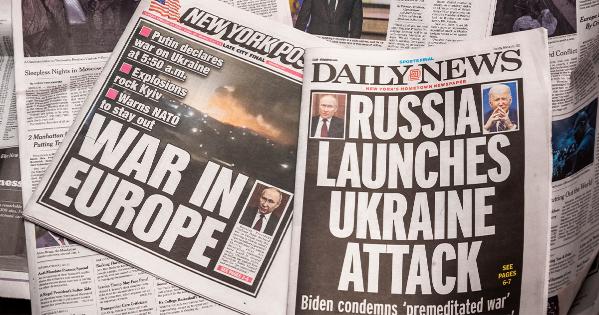Headlines and Front Lines: How US News Coverage of Wars in Yemen and Ukraine Reveals Bias in Recording Civilian Harm
By Jeff Bachman and Esther Brito Ruiz | August 3, 2023
War entails suffering. How and how often that suffering is reported on in the U.S., however, is not evenhanded.
Take, for example, the
Saudi-led intervention in Yemen in March 2015 and the
Russian invasion of Ukraine in February 2022. The media attention afforded to the crises reveals biases that relate less to the human consequences of the conflicts than to the United States’ role and relationship with the warring parties involved.
In Yemen, the
U.S. is arming and
supporting the Saudi-led coalition, whose airstrikes and blockades have caused immense human suffering. Meanwhile in Eastern Europe, the
U.S. is arming and
aiding Ukraine’s efforts by helping to counter missile strikes that have targeted civilian infrastructure and to retake occupied territories where
horrific killings have taken place.
As scholars who study
genocide and other mass atrocities, as well as
international security, we compared New York Times headlines that span approximately seven and a half years of the ongoing conflict in Yemen and the first nine months of the conflict in Ukraine.
We paid particular attention to headlines on civilian casualties, food security and provision of arms. We chose The New York Times
because of its popularityand reputation as a
credible and influential source on international news, with an
extensive network of global reporters and over
130 Pulitzer Prizes.
Purposefully, our analysis focused solely on headlines. While the full stories may bring greater context to the reporting, headlines are particularly important for three reasons: They frame the story in a way that
affects how it is read and remembered; reflect
the publication’s ideological stance on an issue; and, for many news consumers, are the
only part of the story that is read at all.
Our research shows extensive biases in both the
scale and tone of coverage. These biases lead to reporting that highlights or downplays human suffering in the two conflicts in a way that seemingly coincides with U.S. foreign policy objectives.
Ukraine in spotlight
War in Ukraine is clearly seen as more newsworthy to U.S. readers. This double standard may have less to do with the actual events than that the victims are white and “
relatively European,” as one CBS News correspondent put it.
Our broad search of New York Times headlines concerning the overall civilian impact of the two conflicts yielded 546 stories on Yemen between March 26, 2015, and Nov. 30, 2022. Headlines on Ukraine passed that mark in under three months and then doubled it within nine months.
Front-page stories on Ukraine have been commonplace ever since the
Russian invasion began in February 2022. In comparison, front-page stories on Yemen have been rare and, in some cases, as with coverage on food security in the country, came more than three years after the coalition initiated blockades that led to the crisis.
The first front-page article with explicit focus on the hunger crisis was published on June 14, 2018, with the headline “Saudi-Led Attack Deepens the World’s Worst Humanitarian Crisis.” By this point, 14 million Yemenis were already facing “
catastrophic food insecurity,” according to the United Nations Office of the High Commissioner for Human Rights.
More context on Ukraine
When we analyzed headlines on Yemen and Ukraine, we classified them as either “episodic,” meaning focused on specific events, or “thematic,” meaning more contextual. An example of an episodic headline is “
Apparent Saudi Strike Kills at Least Nine in Yemeni Family.” An example of a thematic headline is “
Ferocious Russian Attacks Spur Accusations of Genocide in Ukraine.”
New York Times headlines on Yemen were mostly focused on events, accounting for 64% of all headlines. In contrast, headlines on Ukraine involved a greater emphasis on context, accounting for 73% of total articles. The reason this is important is that by focusing more on either episodic or contextualized stories, newspapers are able to lead readers to different interpretations.
The largely episodic headlines on Yemen may give the impression that the harm reported is incidental, rather than symptomatic of the coalition’s violence. Meanwhile, contextual articles on Ukraine trace the broader implications of the conflict and reflect stories of continual Russian responsibility and accountability.
Differences in assigning blame
Accountability in coverage is also vastly different. We found 50 headlines on Yemen that reported on specific attacks carried out by the Saudi-led coalition. Of them, 18 – just 36% – attributed responsibility to Saudi Arabia or the coalition. An egregious example that omits responsibility is this headline from April 24, 2018: “Yemen Strike Hits Wedding and Kills More Than 20.” A reader could easily interpret that as meaning that Yemen rebels were behind the attack rather than the Saudis – as was the case.
It is hard to imagine a Russian strike on a wedding in Ukraine headlined as “Ukraine Strike Hits Wedding and Kills More Than 20.”
Over the period we looked at, there were 54 headlines on specific attacks in Ukraine – 50 of which reported on Russian attacks, with the remaining four reporting on Ukrainian attacks. Here, of the 50 headlines about Russian attacks, 44 of them – or 88% – explicitly attributed responsibility to Russia. Meanwhile, none of the four headlines on Ukrainian attacks attributed responsibility to Ukraine. This shows the selectivity of responsibility attribution – clear in Ukraine when covering Russia’s actions, but often obscured when it comes to the Saudi-led coalition’s attacks in Yemen.
Furthermore, a June 2017 headline portrays the coalition as concerned about the destruction it has caused: “
Saudis Move to Address Civilian Toll in Yemen.” Compare this to how Russia’s attempts to address civilians are categorically dismissed: “
Russia’s Explanations for Attacking Civilians Wither Under Scrutiny.”
A tale of two humanitarian crises
Both invasions have led to situations of food insecurity – in Yemen creating a
national risk of famine, and in Ukraine compromising
global grain supply. However, the way the news stories speak about hunger in both countries has little in common.
Russian actions blocking grain exports and destroying crops and agricultural infrastructure are portrayed as
deliberate and weaponized: “
How Russia Is Using Ukrainians’ Hunger as a Weapon of War.”
In contrast, the Saudi-led coalition’s blockade, despite being the
primary driverof the famine and even
equated to torture by the World Organisation Against Torture, was rarely afforded this intent. In fact, coverage of the hunger crisis often did not mention the coalition at all, such as in this March 31, 2021, headline: “
Famine Stalks Yemen, as War Drags on and Foreign Aid Wanes.”
Out of 73 stories broadly about food security in Yemen, only four unequivocally attributed rising starvation to the actions of the coalition and condemned their role.
Moral outrage vs. neutrality
Headlines on Ukraine tend to invoke moral judgments, we found, compared with a more neutral tone on Yemen. Russia is portrayed as a violent, relentless and merciless villain: “
Russian Forces Pound Civilians …” and “
Russia Batters Ukraine ….” In turn, Ukrainians are presented as heroes who are fighting for the survival of their nation, and they are humanized in their suffering: “
They Died by a Bridge in Ukraine. This Is Their Story.”
This moral positioning on the conflict in Ukraine is not necessarily a problem. After all,
falsely equating Ukraine’s actions with those of Russia fails to account for Russian aggression, which initiated the armed conflict, as well as Russia’s routine targeting of civilian sites.
However, it is noteworthy that New York Times headlines on Yemen fail to employ similarly condemnatory narratives toward the Saudi-led coalition in Yemen. This is despite reports produced by
human rights organizations,
conflicttrackers, and
international and regional experts that have blamed the coalition for the vast majority of civilian suffering.
As a consequence, Yemeni civilians become forgotten victims, unworthy of attention and obscured by
opaque numbers,
detached language on the consequences of coalition violence, and narratives of the
inevitability of war. These editorial decisions obscure the role of the U.S. in Yemeni suffering – even if they do not reflect the underlying intent behind the reporting.
Journalism of deference
In both the Yemen and Ukraine conflicts, the U.S. has spent tens of billions of dollars – more than
US$75 billion in humanitarian, financial and military assistance to Ukraine and over
$54 billion in military support to Saudi Arabia and the United Arab Emirates between 2015 and 2021 alone.
What’s different is that the U.S. is essentially on opposite sides in these conflicts when it comes to its relationship to those inflicting the most civilian casualties. Washington officials have made open and direct declarations about the inhumanity of atrocities in Ukraine while
avoiding inquiry and condemnation of those in Yemen. Our research suggests that such messaging may be supported by the news media.
Esther Brito Ruiz, Adjunct Instructor,
American University School of International Service and
Jeff Bachman, Professorial Lecturer in Human Rights; Director, Ethics, Peace, and Human Rights MA Program,
American University School of International Service
This article is republished from
The Conversation under a Creative Commons license. Read the
original article.







